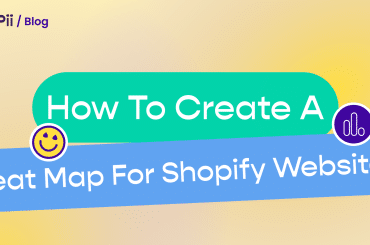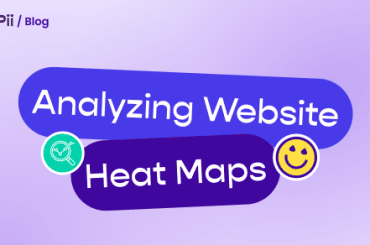As marketers, we have a long list of tools that we leverage to improve our marketing initiatives.
Sometimes we even take some of those tools for granted because we’re used to them.
But once we start working with other departments, we begin to see how they value the tools we’re accustomed to.
One such tool that comes to mind is a heatmap.
I always work side-by-side with UX designers, product designers, and conversion rate specialists – and one thing I noticed is that they both have a heatmap tool in their toolkit.
Although they both work in different spaces, they share the same goal when it comes to using heatmaps. They both want to deliver a positive user experience for their audiences.
When I was doing my research for this post, I had a chat with Jamie Griffiths from ecomplete and Marwa Ismail from Invesp about the importance of heatmaps from a design perspective.
So, if you’re a marketer, designer, e-commerce manager, or CRO specialist, you have to know how to use heatmaps to develop better web designs. And that is exactly what this blog post is about, continue reading to learn more.
4 Reasons Heatmaps Are Helpful For UX Designers

Now, let’s talk about why any designer should care about using heatmaps for their designs.
The argument is clear for some, as heatmaps provide many insights that otherwise you couldn’t have.
But let’s jump into it.
- Get unbiased feedback from users.
Designing isn’t an exact science; they have a big emphasis on the art portion. As you know, there is more than one way to make a design.
Which sometimes creates the issue of “am I biased toward my design?” or “Do I have enough data to back the reasoning behind my design?’
Heatmaps easily enable you to eliminate those thoughts because simply heatmaps will show you whether your users like the design or not.
So you’re getting the raw feedback from your users without asking them while also confirming or debunking any biases you have towards your design.
- Decrease development time and cost by using design tricks like “Fake Doors”
This one is my favorite out of the four because it caught my attention. Here’s what Marwa told me.
‘So I use fake doors in my designs to test where users click, and if they click on the fake doors I created using my designs, then I know that there’s interest in that specific button or area. I then use it to plan my hierarchy.
Also, using fake doors helps us decrease the overall development cost and time since we can “test first, deploy later,” which is one of our mottos at Invesp.
We try out designs, see on heatmap how people interact with them; if we see an increase in clicks and people show interest in our design, we tell the development team to hard code it’
- Changing designs to hit goals without compromising user experience
Marwa told us about her experience changing designs based on feedback from the users that she could see from the heatmap.
“For one of our clients, I discovered – with the help of a CRO specialist – that by changing the order of the sections on the website, we could increase the conversion rate without removing or adding any features to the design.
We noticed that users were more interested in certain sections than others by analyzing heatmaps. So we followed our users’ hierarchy and changed the order of the section based on what we had seen on heatmaps.
Surprisingly, Jamie said a similar thing about scroll heatmaps
“Sometimes, you might not be sure what people are interested in, and you place important content at the bottom of the page. But using heatmaps, you can see how people are scrolling and what exactly they are clicking on.
So you need to restructure your product page based on your findings and test out to see how you can drive more conversions.”
- A big part of conversion optimization is improving UX.
Conversion rate optimization is a visually driven marketing process because to increase conversion; you need to dive into what makes people tick.
And that’s why CRO teams – either in-house or from agencies – have a couple of UX designers in their teams.
Because at the end of the day, you want to have tangible improvements in your UX design, and the way to achieve that is by using heatmaps to understand their clients’ users.
From heatmaps, you can see what patterns emerge and how you can improve how users navigate the website.
Then CROs and Designers create an improved user flow based on the navigational pattern they observed by looking at heatmaps.
Can Heatmaps Help Designers Be More Efficient?

Even though that question sounds like a no-brainer, I had to ask Jamie and Marwa. And they both gave me two different but interesting answers.
I’ll tell you what they had to say, and I’ll let you be the judge, but remember this: there’s no right answer or wrong answer in how people do their work duties.
So if you agree or disagree with someone, that doesn’t make them right or wrong; it makes them similar to your work style, so be open to other viewpoints and ideas.
Here’s what Marwa said:
‘I use heatmaps all the time in my work, so I’d say they make me efficient for sure because I want to analyze my designs.
I want to know what elements get more clicks so I can double down on them, and the fastest way to know that is by taking a look at a heatmap report.
Also, I need to see how I would work out my design hierarchy; I want to have the elements that people engage with the most on top of my designs to show the important info as soon as the user lands on the page.
Before each experiment we run, I need to take a look at the heatmap report’
Jamie had another opinion about them; here’s what he said.
‘No, I don’t think a heatmap makes you more efficient on its own; it’s one tool that aids you when you’re designing.
They’re good at validating certain design decisions that you take and reflecting on things in the design you might’ve missed.
For example, if there’s a link on the product page that you might not think is important, you run your heatmap analysis and see that many people are engaged with it.
They can be useful in uncovering these kinds of things, but making things more efficient or making decisions based on just heatmaps is risky and doesn’t make designs more efficient.’
Should Designers Care About Conversion Rates?

I thought a lot before asking this question because conversions and optimizing them is a task for marketers (or so I thought in the past), but what role do designers play in it?
I thought about it and tried to get as much info as possible, but in the end, asking designers is a better approach, so I did just that.
Both of them gave me a similar answer which was, “Yes, designers should care about conversion rates”
When I asked Marwa about it, she told me:
‘Designers should care about conversion rates because that’s a part of the designing process; we’re not just designing stuff to look pretty; they also need to yield a better conversion rate.
I work closely with the marketing department to see if there’s something they want to have higher in the hierarchy of the designs, so I include it.
But I usually put myself in the shoes of my users, trying to figure out their behavior and how they respond to my designs to adjust accordingly.’
Jamie gave me a similar answer:
‘I think conversions are a mere reflection of how well customers respond to a design, how well customers respond to your product, and how well you communicate that product, whether visually or descriptively.
Although it is not the be-all and end-all, different aspects can impact the conversion rate.
Conversion rates ultimately help drive the bottom line, which is to increase the revenue of your business so, in the end, it’s a fundamental part of designs.’
Conclusion
So that’s it; heatmaps are important for any designer.
Both Marwa and Jamie presented excellent points and valid discussions at the end of the day.
Heatmaps are an integral part of the designing process; there’s no hesitation about it.
But the devil is in the details.
Marwa and Jamie presented us with ways heatmaps help designers increase conversion rates.
What do they focus on whenever they’re designing, and how do heatmaps aid them in their work.
Hopefully, this blog will make your decision-making process sharper with the help of using heatmaps!



